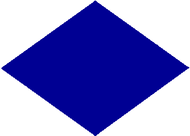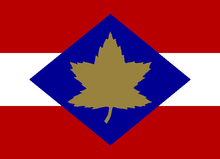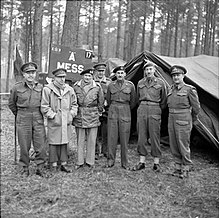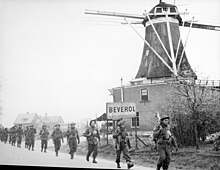II Canadian Corps
This article includes a list of references, related reading, or external links, but its sources remain unclear because it lacks inline citations. (February 2012) |
| II Canadian Corps | |
|---|---|
 Formation patch worn by corps-level personnel. | |
| Active | 1943–1945 |
| Country | Canada |
| Branch | Canadian Army |
| Type | Corps |
| Size | Two Canadian infantry divisions, one Canadian armoured division, 1st Polish Armoured Division, units from other Allied countries. |
| Командиры | |
| Примечательный командиры | Гай Саймондс |

II Canadian Corps was a corps-level formation that, along with I (British) Corps (August 1, 1944, to April 1, 1945) and I Canadian Corps (April 6, 1943, to November 1943, and April 1, 1945, until the end of hostilities), comprised the First Canadian Army in Northwest Europe during World War II.
Authorization for the formation of the corps headquarters became effective in England on January 14, 1943. Over March 4–12 the new Canadian corps was involved in Exercise Spartan, a large-scale training exercise in southern England. This exercise revealed weaknesses in the command of both the new Corps and of First Canadian Army, and this led directly to several changes in leadership over the subsequent year.
The first commander of II Canadian Corps was Lieutenant-General Ernest William Sansom, effective January 15, 1943. Concerns over his leadership abilities and health caused Sansom to be replaced by Lieutenant-General Guy Simonds on January 29, 1944. Simonds led the corps for the remainder of its existence. On May 5, 1945, at Bad Zwischenahn in Northern Germany, Simonds accepted the surrender of German forces facing II Canadian Corps at the end of the war. The corps was deactivated on June 25 as part of general demobilization.
2-й канадский корпус открыл свой первый тактический штаб в Нормандии в Амбли 29 июня 1944 года. Штаб вступил в полную боевую готовность 7 июля, когда 2-я канадская пехотная дивизия начала прибывать во Францию. К этой первой дивизии вскоре присоединились 3-я канадская пехотная дивизия и 2-я канадская бронетанковая бригада , которые ранее участвовали в высадке в Нормандии и в операции «Виндзор» в составе I (британского) корпуса. 4- я канадская (бронетанковая) дивизия была третьей канадской дивизионной составляющей корпуса. Наконец, на протяжении большей части кампании по Северо-Западной Европе в состав корпуса также входила 1-я польская танковая дивизия .
Хотя номинально II канадский корпус был канадским формированием, в разное время в него входили значительные средства из других стран -союзников . Помимо 1-й польской танковой дивизии, в состав корпуса входили 1-я Бельгийская пехотная бригада , Королевская нидерландская моторизованная пехотная бригада и 51-я (Хайлендская) пехотная дивизия .
Основные операции
[ редактировать ]

2-й канадский корпус участвовал в боевых действиях в Северо-Западной Европе с начала июля 1944 года до дня Победы в начале мая 1945 года. Во время битвы за Нормандию корпус использовался, чтобы возглавить британско-канадское наступление от Кана до Фалеза . После окончательного закрытия Фалезского коридора 21 августа 1944 года оставшиеся немецкие войска на севере Франции были вынуждены быстро отступить к оборонительным позициям в портовых городах вдоль побережья, а также в регионах к югу от Нидерландов и за пределами Франции. западные границы Германии, в Бельгии и восточной Франции. Первая канадская армия сформировала левый фланг наступающих союзных армий, и ей было поручено захватить или блокировать оккупированные немцами порты на севере Франции и в Бельгии. Дьепп , Булонь , Кале , Кап-Гри-Нез и Остенде были захвачены в сентябре войсками II канадского корпуса. Однако оборона Дюнкерка оказалась настолько сильной, что оккупированный немцами портовый город было решено оставить в осаде до конца европейской войны. Антверпен был захвачен Второй британской армией 4 сентября, но крупные портовые сооружения города были бесполезны для союзников, пока немецкие войска продолжали оккупировать берега устья Шельды . В качестве авангарда Первой канадской армии 2-й канадский корпус принимал активное участие в битве при Шельде, чтобы зачистить немецкие позиции. 2-й канадский корпус участвовал в боях по изгнанию немецких войск из восточных провинций Нидерландов обратно через западную границу Германии, а затем по вытеснению их с западного берега реки Рейн . На заключительном этапе войны 2-й канадский корпус продвинулся в северные провинции Нидерландов и через границу с Германией к побережью Северного моря . 5 мая 1945 г. генерал-лейтенант. Саймондс получил безоговорочную капитуляцию немецких войск, стоящих перед корпусом на севере Германии.


- Операция «Атлантик» , форсирование реки Орн и неудачная попытка захватить хребет Верьер , район к югу от Кана, 18–21 июля 1944 года.
- Operation Spring, assault against Verrières Ridge, July 25–28, 1944
- Operation Totalize, capture of Verrières Ridge and advance towards Falaise, Normandy, August 8–13, 1944
- Operation Tractable, capture of Falaise, Normandy, August 14–21, 1944
- Advance up to and then across the River Seine at Elbeuf and Rouen, Aug. 23–28, 1944
- Liberation of Dieppe, abandoned by the retreating German Army, Sept. 1, 1944
- Investment of Dunkirk as the initial part of the 8-month-long siege of that port city, Sept. 7-18, 1944
- Liberation of Ostend, Sept. 9, 1944
- Liberation of Bruges, Sept. 12, 1944
- Operation Wellhit, capture of Boulogne, September 17–22, 1944
- Operation Undergo, capture of Calais and the heavy batteries at Cap Gris Nez, September 25–30, 1944
- Operation Switchback, clearing area north of the Albert Canal, Belgium, October 6 to November 3, 1944
- Operation Vitality, South Beveland peninsula and Walcheren Island, the Netherlands, October 24 to November 3, 1944
- Operation Infatuate I, South Beveland, October 26, 1944
- Operation Veritable, Reichwald Forest, Germany, February 8 to March 11, 1945
- Operation Blockbuster, Hochwald gap and the capture of Xanten on the Rhine River, Germany, February 23 to March 3, 1945
- Battle of Friesoythe, April 13-14 1945
- Battle of Groningen, northern Netherlands, April 14–18, 1945
- Operation Duck, crossing of the Ems River and the capture of Leer, April 28 to May 4, 1945
- Capture of Oldenburg, April 25 to May 4, 1945
Commanders
[edit]- Lieutenant-General Ernest William Sansom (January 15, 1943 to January 29, 1944)
- Lieutenant-General Guy Simonds (January 29, 1944 to June 25, 1945)
Order of battle
[edit]- 2nd Canadian Infantry Division
- 3rd Canadian Infantry Division
- 4th Canadian (Armoured) Division
- 1st Polish Armoured Division, August 1944 to May 1945
- 15th (Scottish) Infantry Division, January to March, 1945
- 51st (Highland) Infantry Division, August 1944
- 2nd Canadian Armoured Brigade
- 33rd Armoured Brigade, August 1944, Operation Totalize
- 1st Belgian Infantry Brigade, April 1945
- Royal Netherlands Motorized Infantry Brigade, August 1944
- 1st Czechoslovak Armoured Brigade, October–November 1944, Siege of Dunkirk
- Corps troops
- 2nd Corps Defence Company (The Prince Edward Island Light Horse)
- 18th Armoured Car Regiment (12th Manitoba Dragoons)
- 6th Light Anti-Aircraft Regiment, Royal Canadian Artillery (RCA)
- 6th Anti-Tank Regiment, RCA
- 2nd Survey Regiment, RCA
- 8th Field Park Company, Royal Canadian Engineers (RCE)
- 29th, 30th and 31st Field Companies, RCE
- 2nd Drilling Company, RCE
- II Canadian Corps Headquarters Signals, Royal Canadian Corps of Signals
- No. 2 Corps Troops Company, Royal Canadian Army Service Corps (RCASC)
- II Canadian Corps Transport Company, RCASC
- No. 33 and 34 Transport Companies, RCASC
- No. 2 Motor Ambulance Company, RCASC
- No. 2 Headquarters Corps Car Company, RCASC
- No. 2 and 3 Casualty Clearing Stations, Royal Canadian Army Medical Corps (RCAMC)
- No. 6 Field Dressing Section, RCAMC
- No. 8 Field Hygiene Section, RCAMC
- unknown Dental Companies, Canadian Dental Corps (CDC)
- No. 12 Base Dental Company, CDC
- No. 2 Corps and Army Troops Sub-Park, Royal Canadian Ordnance Corps (RCOC)
- II Corps Troops Workshop, Royal Canadian Electrical and Mechanical Engineers (RCEME)
- Recovery Compani(es), RCEME
- No. 13 Provost Company, Canadian Provost Corps (C Pro C)
- Attached First Canadian Army Troops
- No. 2 Army Group Royal Canadian Artillery
- 19th Army Field Regiment, RCA
- 3rd Medium Regiment, RCA
- 4th Medium Regiment, RCA
- 7th Medium Regiment, RCA
- "E" Squadron, 25th Armoured Delivery Regiment (The Elgin Regiment), Canadian Armoured Corps
- No. 2 Army Group Royal Canadian Artillery
References
[edit]- Byers, A. R. (ed.), The Canadians at War 1939/45, 2nd ed., The Reader's Digest Association (Canada) Ltd., Montreal, Canada, 1986, ISBN 0-88850-145-5.
- Brown, Angus and Gimblett, Richard, In the Footsteps of First Canadian Army: Northwest Europe 1942-1945, Magic Light Publishing, Ottawa, 2009, ISBN 1-894673-33-6.
- Copp, Terry, Fields of Fire: The Canadians in Normandy, University of Toronto Press, Toronto, Canada, 2004, ISBN 978-0-8020-3780-0.
- Copp, Terry, Cindarella Army: The Canadians in Northwest Europe 1944-1945, University of Toronto Press, Toronto, Canada, 2007, ISBN 978-0-8020-9522-0.
- Stacey, C.P. (1960). Official history of the Canadian Army in the Second World War, Vol III The Victory Campaign, The Operations in Northwest Europe 1944-1945. Ottawa: Queen's Printer.
- Zuehlke, Mark, Terrible Victory: First Canadian Army and the Scheldt Estuary Campaign: September 13 – November 6, 1944, Douglas & McIntyre, 2009, ISBN 1-55365-404-8.
- "History of the 6th Canadian anti-tank regiment, Royal Canadian Artillery, 1st April, 1942-24th June, 1945" (Toronto, Regiment, 1946)